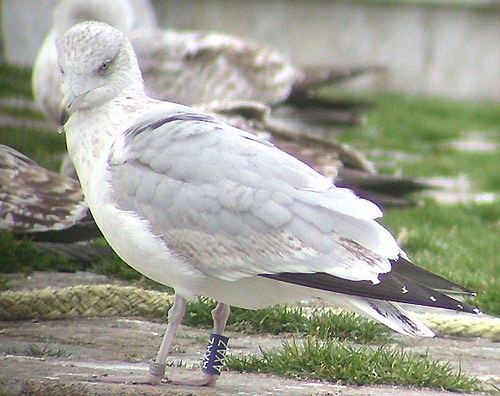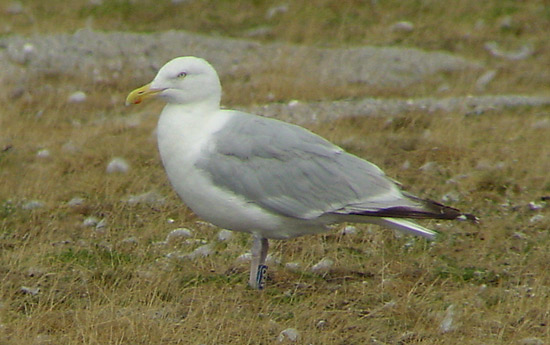 Herring
Gull - Zilvermeeuw (argentatus & argenteus): sub-adult February
Herring
Gull - Zilvermeeuw (argentatus & argenteus): sub-adult February
(last update: 07 april 2004)
Home
Links
to Gull Sites
Gull Taxa
Gull Topography
Grey & Colour Charts
Locations in NW Europe
Summaries of Articles
About ORG
@
Herring Gull AXAZ 4-5cy (argenteus), February 2002 - August 2003.
An argenteus ringed as pullus blue AXAZ on July 13 1999 at Zeebrugge, Belgium.
below: AXAZ 4cy (argenteus), February 2002, Port of Calais, France (50,41N 1,35E). Picture by Jean-Pierre Leys.
This agenteus shows all the familiar characteristics of a 4cy in February:
- note the small white mirror on P10, visible from below,
- the white tips of the third generation primaries are relatively small compared to the primaries of an adult argenteus Herring Gull,
- the tail has obvious vestiges of immaturity: black central markings,
- the fourth tertial has much brown patterning and is probably the oldest tertial (but not necessarily of an earlier generation than the other tertials, as the tertial moulted first in line may appear much more immature than later acquired feathers of the same tract),
- a combination of completely adult-like scapular and mantle region and patterned (barred) greater and median coverts,
- the extensive dark bill-band and greyish iris.
From January to April, 4cy argenteus moult to so-called "third summer" plumage. By April, the head and under-parts will appear all-white. The tail-feathers, wing-coverts and primaries are not replaced, therefore most birds strongly resemble "third winter" birds, although the white primary tips wear away and dark patches start to bleach. The iris is often yellowish, the orbital ring yellowish-orange and the bill predominantly yellow with a red gonydeal spot and limited black markings along the culmen by April.
Many thanks to Jean-Pierre Leys.

Herring Gull AXAZ 5cy (argenteus), August 01 2003, Zeebrugge, Belgium.
A bird with a blue Belgian ring: AXAZ, from the Zeebrugge colony, ringed as pullus at Zeebrugge (51.21N 03.11E) on July 13 1999. P7-P10 are still old. The red gonydeal spot is confined to the lower mandible and the bill has very limited black.
From June (often mid-May in France, Belgium and the Netherlands) to October, a complete moult will bring birds in so-called "adult winter" plumage. A new set of primaries will grow during the summer months and by August, the outermost primaries P7-P10, are still present in argenteus in the Netherlands and northern France. In most adults, the new primary P5 is just visible beneath the tertials. At the same time, the outer median coverts, outer lower lesser and innermost greater coverts have been renewed and contrast with the old, abraded adjacent wing-coverts. The central median coverts are still missing. In summer, the head is still largely white, but by the end of the summer, most adults develop extensive 'winter streaking', in sub-adults strongly mottled brown contrasting with the white breast as in an executioner's hood. The iris is yellow in adults. The bill is yellow with a red gonydeal spot confined to the lower mandible in the vast majority of adults. The orbital ring is yellow-orange or orange-red in argenteus. The legs are flesh-pink in Dutch argenteus, although the odd individual shows slightly yellowish legs.
| Remaining old primaries in adult (>4cy) Herring Gull in the Netherlands. | ||||||
| . | 17.08.00 | 21.08.01 | 22.08.01 | 23.08.00 | 28.08.00 | 30.08.00 |
| P10 | - | - | - | - | 1 | - |
| P9-P10 | - | - | - | 3 | 6 | 7 |
| P8-P10 | 8 | 7 | 17 | 47 | 29 | 33 |
| P7-P10 | 28 | 33 | 22 | 44 | 15 | 9 |
| P6-P10 | 10 | 10 | 7 | 12 | 2 | 2 |
| n: | 46 | 50 | 46 | 106 | 53 | 51 |
| m: | 4,0 | 4,1 | 3,8 | 3,6 | 3,2 | 3,1 |
| 95% CID: | 0,19 | 0,17 | 0,21 | 0,14 | 0,21 | 0,19 |
| SD: | 0,63 | 0,59 | 0,70 | 0,72 | 0,77 | 0,68 |
Notes: |
||||||
